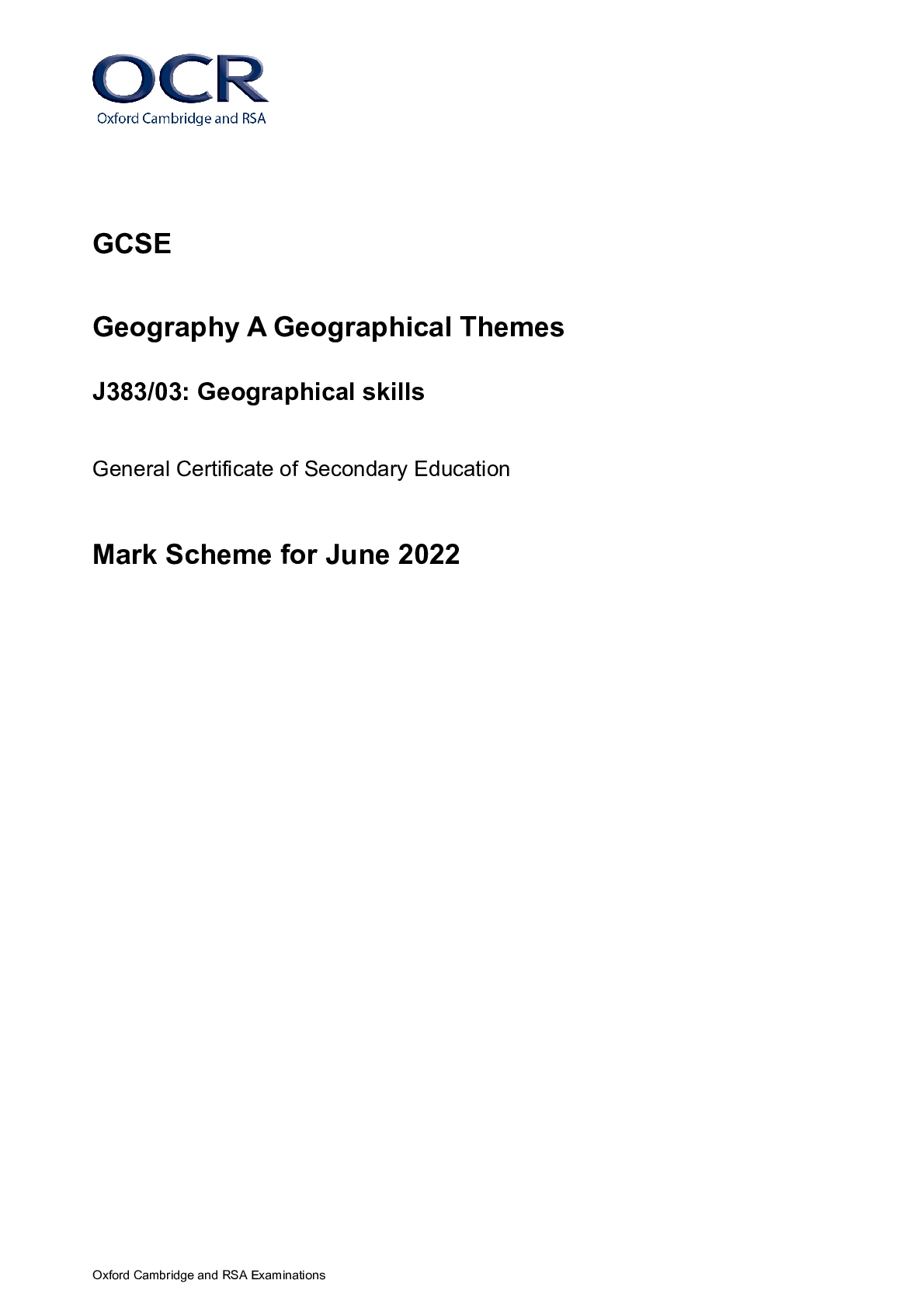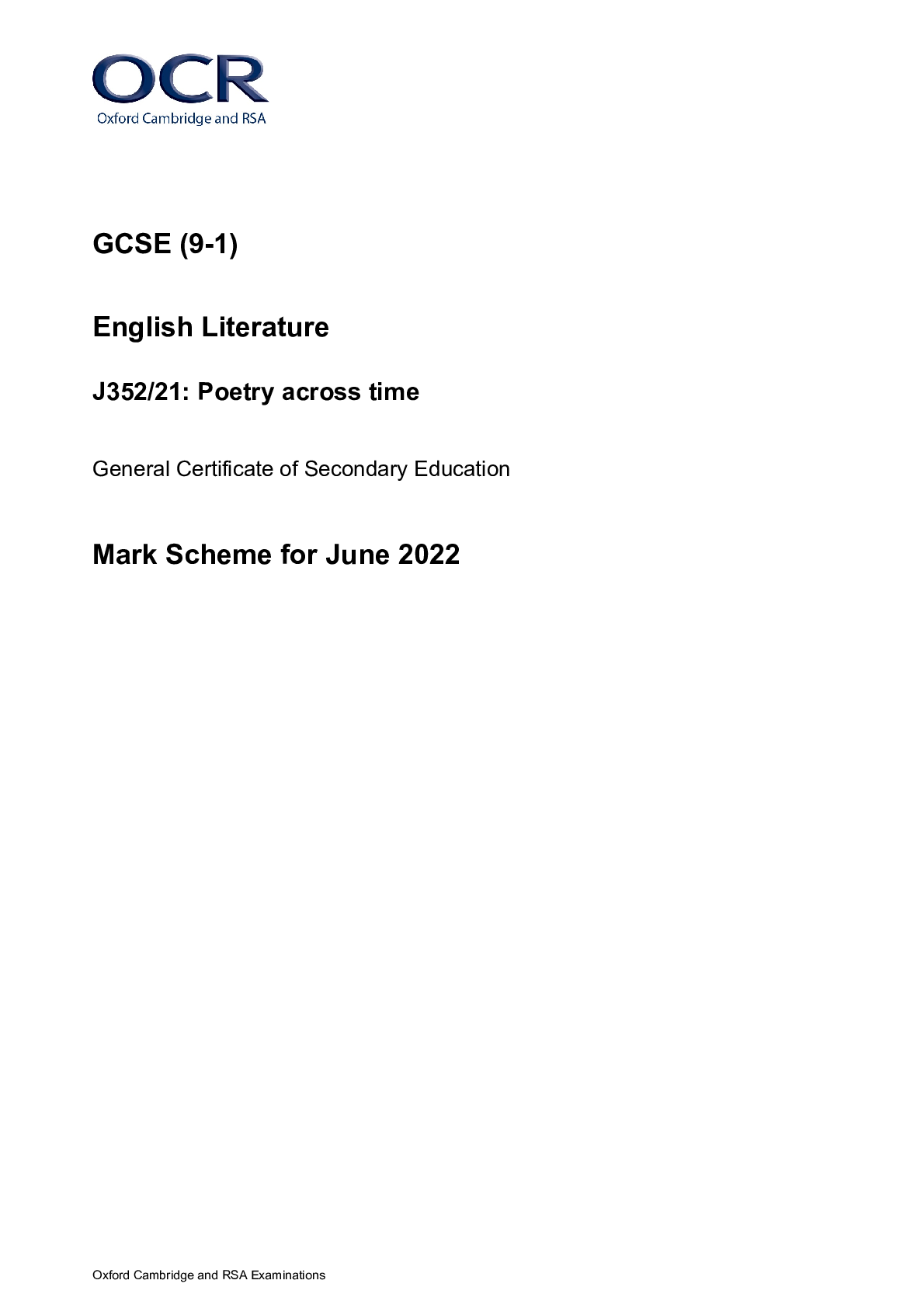Biology > GCSE MARK SCHEME > GCE Biology A H420/02: Biological diversity Advanced GCE Mark Scheme for November 2020 (All)
GCE Biology A H420/02: Biological diversity Advanced GCE Mark Scheme for November 2020
Document Content and Description Below
GCE Biology A H420/02: Biological diversity Advanced GCE Mark Scheme for November 2020 Oxford Cambridge and RSA Examinations GCE Biology A H420/02: Biological diversity Advanced GCE Mark Scheme ... for November 2020Oxford Cambridge and RSA Examinations OCR (Oxford Cambridge and RSA) is a leading UK awarding body, providing a wide range of qualifications to meet the needs of candidates of all ages and abilities. OCR qualifications include AS/A Levels, Diplomas, GCSEs, Cambridge Nationals, Cambridge Technicals, Functional Skills, Key Skills, Entry Level qualifications, NVQs and vocational qualifications in areas such as IT, business, languages, teaching/training, administration and secretarial skills. It is also responsible for developing new specifications to meet national requirements and the needs of students and teachers. OCR is a not-for-profit organisation; any surplus made is invested back into the establishment to help towards the development of qualifications and support, which keep pace with the changing needs of today’s society. This mark scheme is published as an aid to teachers and students, to indicate the requirements of the examination. It shows the basis on which marks were awarded by examiners. It does not indicate the details of the discussions which took place at an examiners’ meeting before marking commenced. All examiners are instructed that alternative correct answers and unexpected approaches in candidates’ scripts must be given marks that fairly reflect the relevant knowledge and skills demonstrated. Mark schemes should be read in conjunction with the published question papers and the report on the examination. © OCR 2020Annotations Annotation Meaning DO NOT ALLOW Answers which are not worthy of credit IGNORE Statements which are irrelevant ALLOW Answers that can be accepted ( ) Words which are not essential to gain credit __ Underlined words must be present in answer to score a mark ECF Error carried forward AW Alternative wording ORA Or reverse argumentH420/02 Mark Scheme November 2020 4 Subject-specific Marking Instructions INTRODUCTION Your first task as an Examiner is to become thoroughly familiar with the material on which the examination depends. This material includes: • the specification, especially the assessment objectives • the question paper • the mark scheme. You should ensure that you have copies of these materials. You should ensure also that you are familiar with the administrative procedures related to the marking process. These are set out in the OCR booklet Instructions for Examiners. If you are examining for the first time, please read carefully Appendix 5 Introduction to Script Marking: Notes for New Examiners. Please ask for help or guidance whenever you need it. Your first point of contact is your Team Leader.H420/02 Mark Scheme November 2020 5 Question Answer Marks AO element Guidance 1 A 1 1.1 2 D 1 1.1 3 D 1 2.5 4 D 1 1.1 5 B 1 2.3 6 A 1 1.1 7 A 1 2.2 8 A 1 2.1 9 C 1 2.5 10 D 1 1.2 11 D 1 1.2 12 C 1 1.1 13 D 1 1.2 14 C 1 1.2 15 A 1 2.1 Total 15H420/02 Mark Scheme November 2020 20 Question Answer Marks AO element Guidance 16 (a) homeobox DNA transcription plant kingdoms 5 1.1 (b) (i) 1 2 3 45 low cost rapid reproduction (rate) / more generations in a given time idea that fruit fly genetics / development is well understood simple , genetics / body plan (many) mutations / structures , observable with , light / low powered , microscope 2 max 3.4 1 ALLOW easy to keep 1 IGNORE small 2 ALLOW short lifespan / grow quickly (ii) low cost / rapid reproduction (rate) or genetics / development , well understood (more) similar / AW , to humans idea that can show effects are generalisable to more than one species idea that more than one species is needed to demonstrate conservation of base sequence 2 max 3.4 ALLOW easy to keep / short lifespan / grow quickly IGNORE small ALLOW share more genes with humans IGNORE homeobox sequence similar to humans ALLOW because they are mammalsH420/02 Mark Scheme November 2020 7 Question Answer Marks AO element Guidance 17 (a) in , (named) matrix / gel adsorption / bonding to (named) carrier membrane separation cross-linking / covalent bonding 1 max 1.2 ALLOW entrapment / encapsulation / inclusion / microcapsulation ALLOW carrier bound ALLOW attached to partially permeable membrane (b) (i) FIRST CHECK ON ANSWER LINE If answer = 6.8 +/- 0.8 award 2 marks 7.5/1.1 = 6.8181∙ rounded to 2 s.f. = 6.8 2 2.4 ALLOW mp 2 for incorrect answer rounded to 2 s.f (ii) smooth curve AND goes through or near at least 7 points 1 3.3 DO NOT CREDIT extrapolations (iii) 1 2 3 4 5 no value between pH5.5 and pH6 measured peak / optimum , could be anywhere between pH5.5 and pH6 peak / optimum , for immobilised tannase could be anywhere between pH 5 and pH6.5 no indication that the experiment has been repeated AVP 3 max 3.2 1 ALLOW without smaller intervals the student cannot be certain 1 ALLOW examples of untested pH values within this range 2 & 3 DO NOT CREDIT optimum is 5.75 4 ALLOW enzyme activity is not stated as a 'mean' 4 IGNORE not repeated 5 CREDIT pH scale is , non linear / logarithmic 5 CREDIT 10 a.u. is Vmax for this enzymeH420/02 Mark Scheme November 2020 8 Question Answer Marks AO element Guidance (iv) (immobilised enzymes are) less easily denatured shape / tertiary structure , supported / AW (by support material) idea that part of enzyme not fully exposed to pH (8) 2 max 2.2 ALLOW ora for free tannase throughout ALLOW does not denature ALLOW bonds less easily disrupted (c) (i) 1 2 3 4 5 product not contaminated with enzyme extraction of , product / enzyme , not needed recycling (of enzyme) idea that process can be run over wider temperature range (bioreactors) can be run continuously for long periods, so less emptying / cleaning needed 2 max 1.2 2 ALLOW reduced downstream processing 3 ALLOW enzyme can be reused / less enzyme needed 4 ALLOW e.g. can be run at lower temperatures so less energy cost / can be run at higher temperatures so faster (ii) high(er) , initial / set-up , costs fewer exposed active sites idea that immobilization method might affect shape of active site idea of leakage 1 max 1.2 ALLOW immobilization process is expensive IGNORE more expensive to buy ALLOW active sites and substrates mix more slowlyH420/02 Mark Scheme November 2020 9 Question Answer Marks AO element Guidance 18 (a) (i) FIRST CHECK ON ANSWER LINE If answer = 0.41 award 2 marks 13/32 correct answer to 2 s.f. 2 2.4 Max 1 if answer given as % (ii) 1 23 45 supports because… species B has greater (calculated genetic) polymorphism (than species A) ora might not support because… numbers / polymorphisms , are similar no statistical test performed might not have sampled same loci no indication of (fruit flies) sample size 3 max 3.1 3.2 1 ALLOW ecf from calculated answer to part (i) 4 IGNORE different numbers of gene loci studied 5 IGNORE sample size is small (b) (i) bar chart drawn AND x-axis labelled ‘phenotype’ AND linear y-axis scale labelled ‘frequency’ bars correct height and same width bars fill half the available (vertical) space bars labelled / key AND tongue rolling and non-tongue-rolling bars do not touch 4 3.3 DO NOT CREDIT stacked bars Y-axis must start at 0 ALLOW all 4 bars not touchingH420/02 Mark Scheme November 2020 10 Question Answer Marks AO element Guidance (ii) FIRST CHECK ON ANSWER LINE If answer = 0.5 or 0.49 or 0.493 or 0.494 award 3 marks q2 = 77/248 = 0.31 q = √ 0.31 = 0.557 p = 1 – 0.557 = 0.443 2pq = 2 x 0.443 x 0.557 = 0.494 3 2.4 IGNORE sig. figs for working marks If answer incorrect, ALLOW either half of working equations for 1 mark each up to a maximum of 2. ALLOW e.g. ‘q2 = 77/248’ or ‘77/248 = 0.31’ (iii) (population) not (sufficiently) large (population) not randomly mating / not subject to selection 2 2.3 Mark the first answer on each prompt line ALLOW ora in context of Hardy-Weinberg assumptions ALLOW mutations might occur IGNORE immigration / emigrationH420/02 Mark Scheme November 2020 11 Question Answer Marks AO element Guidance 19 (a) (i) prophase then metaphase then anaphase then telophase 2 1.2 MAX 1 if interphase or cytokinesis mentioned ALLOW 1 mark if phases named correctly but not in correct order (ii) genetically identical offspring offspring produced , rapidly / in large numbers (all) offspring will , find conditions favourable / have same adaptations 2 max 2.1 IGNORE clones ALLOW produces more offspring ALLOW finding mate requires , time / energy ALLOW population can increase rapidly IGNORE ‘quicker’ without some qualification (b) (i) Please refer to the marking instructions on page 4 of this mark scheme for guidance on how to mark this question. In summary: Read through the whole answer. (Be prepared to recognise and credit unexpected approaches where they show relevance.) Using a ‘best-fit’ approach based on the science content of the answer, first decide which of the level descriptors, Level 1, Level 2 or Level 3, best describes the overall quality of the answer. Then, award the higher or lower mark within the level, according to the Communication Statement (shown in italics): o award the higher mark where the Communication Statement has been met. o award the lower mark where aspects of the Communication Statement have been missed. • The science content determines the level. • The Communication Statement determines the mark within a level.H420/02 Mark Scheme November 2020 12 Level 3 (5–6 marks) Explains in detail how sexual reproduction leads to genetic variation with reference to more than one stage of meiosis and with reference to Hydra. There is a well-developed line of reasoning which is clear and logically structured. The information presented is relevant and substantiated. Level 2 (3–4 marks) Explains in some detail how sexual reproduction leads to genetic variation with reference to more than one stage of meiosis OR with reference to Hydra and one stage of meiosis. There is a line of reasoning presented with some structure. The information presented is in the most-part relevant and supported by some evidence. Level 1 (1–2 marks) Mentions more than one reason why sexual reproduction leads to genetic variation. The information is basic and communicated in an unstructured way. The information is supported by limited evidence and the relationship to the evidence may not be clear. 0 marks No response or no response worthy of credit. 6 1.1, 1.2 2.5 Indicative points include AO1.1 Demonstrate knowledge and understanding of scientific ideas • genetic variation is the variety of alleles • offspring have alleles from more than one parent • random fertilisation • meiosis produces genetically unique gametes AO1.2 Demonstrate knowledge and understanding of scientific processes • crossing over in prophase 1 • alleles swapped between non-sister chromatids • base sequence of chromosomes altered • independent assortment / random segregation • in metaphase 1 • also relevant in metaphase 2 if crossing over has occurred AO2.5 Apply knowledge and understanding of scientific processes in a theoretical context when handling qualitative data • the sperm from one Hydra can fertilise an egg from any other individual Hydra • the two Hydra can have different alleles 1.1 1.2 2.5H420/02 Mark Scheme November 2020 13 • sperm carried in water • might travel large distances • to unrelated Hydra • Question Answer Marks AO element Guidance (ii) (some offspring) might survive unfavourable conditions (some) offspring have useful alleles (named) unfavourable conditions mean (all) offspring might die (if asexual) 1 max 2.1 IGNORE eggs can lie dormant as stated in question IGNORE less susceptible to unfavourable conditions (c) (i) 224 1 2.2 haploid number = 28 x 2 for diploid number = 56 x 2 after DNA replication = 112 x 2 strands per molecule = 224 (ii) a cross drawn anywhere between sporophyte and spores 1 2.5 (iii) many mitochondria to supply , energy / ATP , for movement OR enzymes / acrosome (enzymes) to , penetrate / AW , egg 2 2.1 Mark the first suggestion given but ignore partially achieved marking points DO NOT CREDIT make energy ALLOW to digest outer layer / break through membrane DO NOT CREDIT break down egg cell wallH420/02 Mark Scheme November 2020 14 Question Answer Marks AO element Guidance 20 (a) (i) A = combustion F = respiration 2 1.2 ALLOW burning IGNORE aerobic / anaerobic (ii) more combustion / less photosynthesis 1 2.6 ALLOW more burning (of fuel) (b) (i) Glucose Starch monomer polymer monosaccharide polysaccharide no glycosidic bonds glycosidic bonds C6H12O6 / more H and O C6H10O5 / less H and O max 3 2.1 2.2 Mark the first 3 responses ALLOW two responses in the same box if they are on the same horizontal level ALLOW glycosidic links IGNORE 1-6 glycosidic bonds IGNORE branched (ii) S / sulfur 1 1.1 ALLOW sulphur (c) Please refer to the marking instructions on page 4 of this mark scheme for guidance on how to mark this question. In summary: Read through the whole answer. (Be prepared to recognise and credit unexpected approaches where they show relevance.) Using a ‘best-fit’ approach based on the science content of the answer, first decide which of the level descriptors, Level 1, Level 2 or Level 3, best describes the overall quality of the answer. Then, award the higher or lower mark within the level, according to the Communication Statement (shown in italics): o award the higher mark where the Communication Statement has been met. o award the lower mark where aspects of the Communication Statement have been missed. • The science content determines the level. • The Communication Statement determines the mark within a level.H420/02 Mark Scheme November 2020 15 Question Answer Marks AO element Guidance Level 3 (5–6 marks) Describes in detail the main similarities between the carbon and nitrogen cycles. There is a well-developed line of reasoning which is clear and logically structured. The information presented is relevant and substantiated. Level 2 (3–4 marks) Describes some of the key similarities between the carbon and nitrogen cycles, at least one similarity is discussed in detail. There is a line of reasoning presented with some structure. The information presented is in the most-part relevant and supported by some evidence. Level 1 (1–2 marks) Mentions some similarities between the carbon and nitrogen cycles. The information is basic and communicated in an unstructured way. The information is supported by limited evidence and the relationship to the evidence may not be clear. 0 marks No response or no response worthy of credit. 6 2.5 Indicative points include AO2.5 Apply knowledge and understanding of scientific processes in a theoretical context when handling qualitative data • inorganic gases o CO2 and N2 • in atmosphere • elements fixed to organic compounds o C and N both form proteins / nucleic acids • incorporated into plants (producers) then animals (consumers) • animals obtain element by feeding on plants • decomposing microorganisms • break down organic macromolecules in living things • release inorganic molecules o carbon dioxide and ammonium ions • microorganisms return element to atmosphere o CO2 released during decomposition o N2 released by denitrifying bacteriaH420/02 Mark Scheme November 2020 16 Question Answer Marks AO element Guidance 21 (a) (i) FIRST CHECK ON ANSWER LINE If answer 91 ± 1or 90.7 ± 1 (%) award 2 marks 215 000 – 20 000 = 195 000 195 000/215000 = 0.907 x 100 = 90.7 2 2.8 Max 1 if answer not given to 2 or 3 s.f. If answer incorrect … ALLOW 195 000/215 000 or 0.907 for 1 mark (ii) idea of changes over time figs with units to illustrate population change 2 2.8 ALLOW calculated change / ref to answer to part (i) (iii) 1 2 3 4 no data shown for , winter months / Dec / Jan / Feb no data shown about temperature or light idea of fluctuations / dips during summer months another , biotic / abiotic , factor could be causing the increase 3 max 3.2 4 ALLOW e.g. increased nutrient availability / reduction in predators / increased CO2 / qualified reference to pollution 4 ALLOW correlation does not imply causal link (b) (i) 1 2 34 5 protoctista nucleus / (named) membrane-bound organelles , so eukaryotic / not prokaryotic unicellular so not plant(ae) cell wall / chloroplast / starch grains, so not animal(ia) cellulose cell wall / chloroplast , so not fungi 4 max 3.1 3.2 1 ALLOW protista 2 IGNORE eukarya 2 IGNORE peptidoglycan 4 IGNORE autotrophicH420/02 Mark Scheme November 2020 17 Question Answer Marks AO element Guidance 5 ALLOW cell wall not chitin so not fungi 5 IGNORE autotrophic (ii) (nucleic acid) base sequence / amino acid sequence genes / DNA / RNA / cytochrome C 1 2.1 ALLOW genetic material IGNORE chromosomes / RNA polymerase / ribosomes DO NOT CREDIT haemoglobin Question Answer Marks AO element Guidance 22 (a) (i) C and F and I and J 1 1.2 ALLOW the correct terms written instead of letters (ii) I and J 1 1.1 ALLOW the correct terms written instead of letters (iii) A and E and G and H 1 1.2 ALLOW the correct terms written instead of letters (iv) F one / few , types of cell performing a function 2 2.1 1.1 ALLOW mucous membrane IGNORE J ALLOW examples of cells involved if one or few types is implied ALLOW similar cells doing the same job (b) cytokines attract / AW , (named) phagocytes 2 1.2 IGNORE increase phagocytosis without reference to movementH420/02 Mark Scheme November 2020 18 Question Answer Marks AO element Guidance opsonins bind to / AW , pathogens / foreign cells / antigens , and increase phagocytosis / recognition by phagocytes (c) (i) type of immunity natural and active natural and passive artificial and active artificial and passive 1 2.5 (ii) injected (patient) is not producing , antibodies / memory cells / immune response 2 1.1 IGNORE natural / artificial / active / passive IGNORE ‘antibodies are given’, as this is in the questionOCR (Oxford Cambridge and RSA Examinations) The Triangle Building Shaftesbury Road Cambridge CB2 8EA OCR Customer Contact Centre Education and Learning Telephone: 01223 553998 Facsimile: 01223 552627 Email: [email protected] [Show More]
Last updated: 1 year ago
Preview 1 out of 20 pages
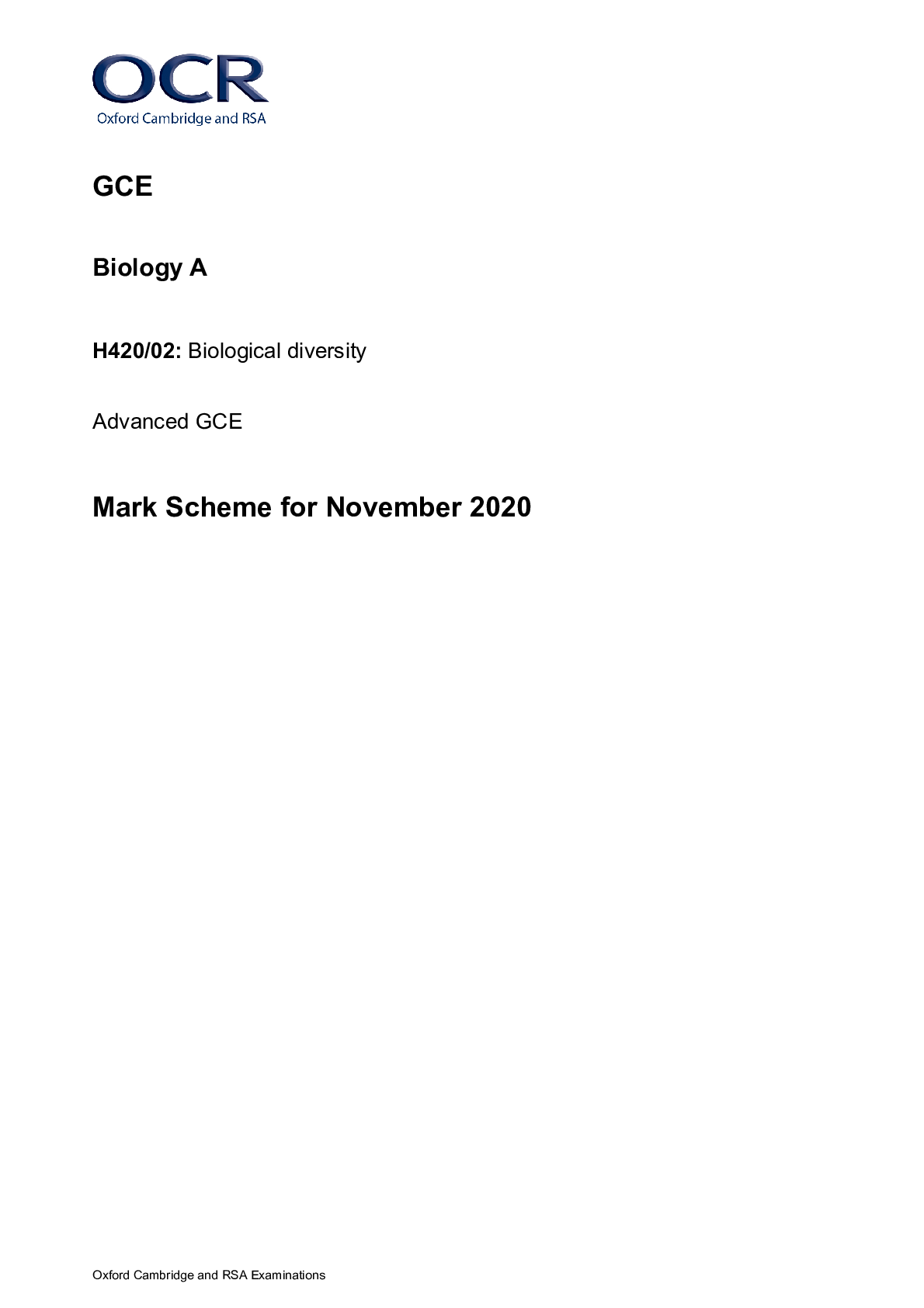
Reviews( 0 )
Document information
Connected school, study & course
About the document
Uploaded On
Oct 07, 2022
Number of pages
20
Written in
Additional information
This document has been written for:
Uploaded
Oct 07, 2022
Downloads
0
Views
37



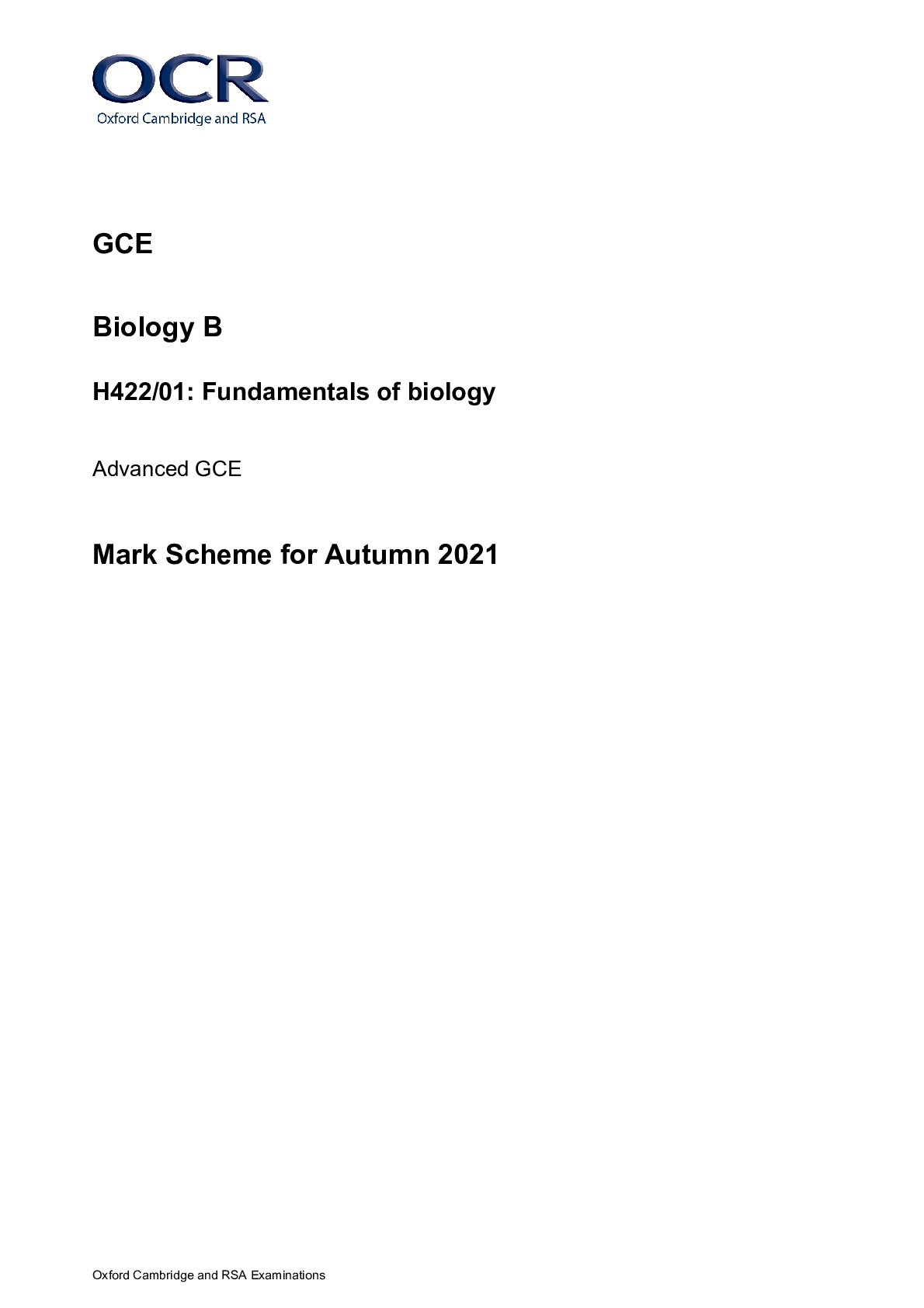
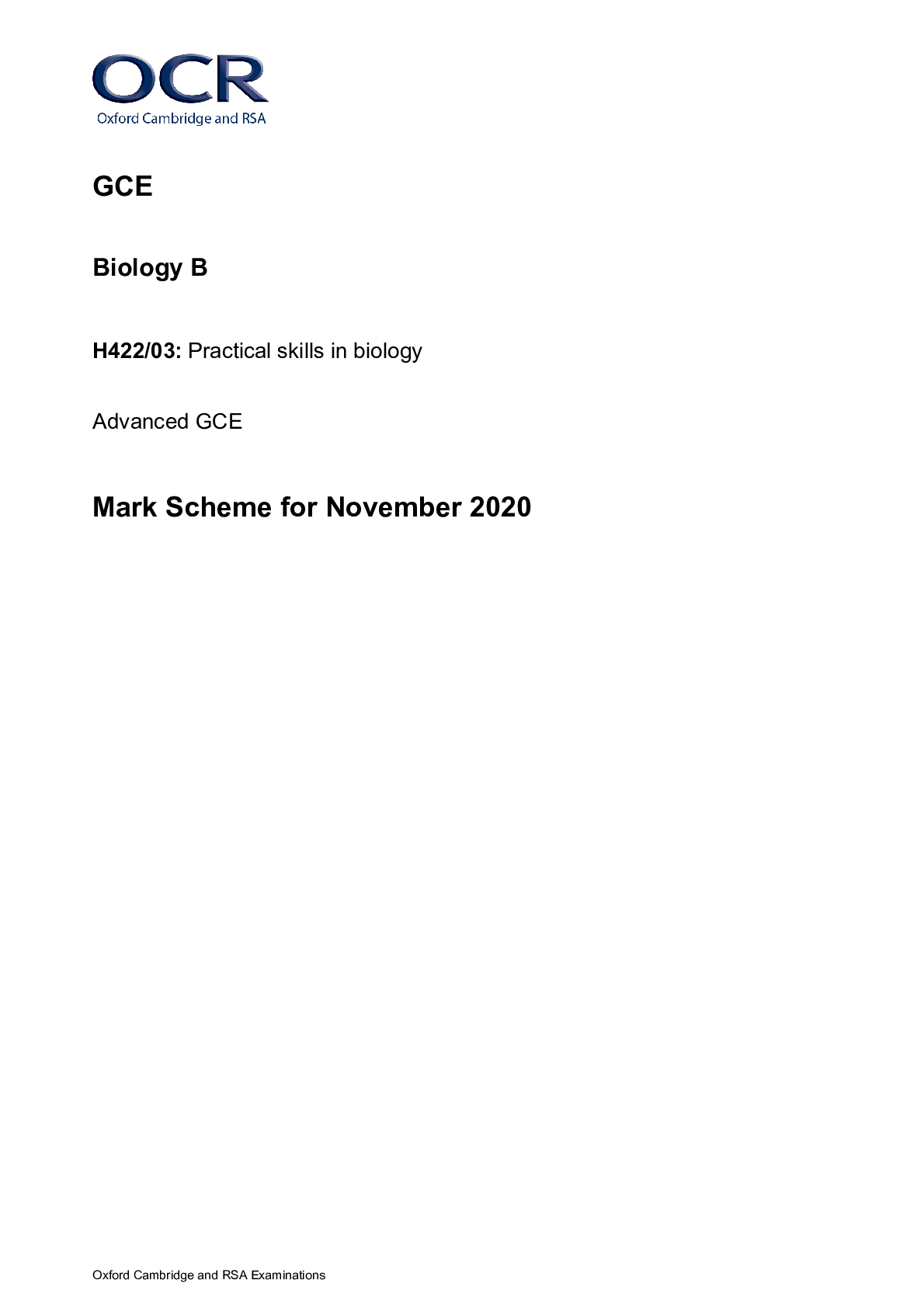
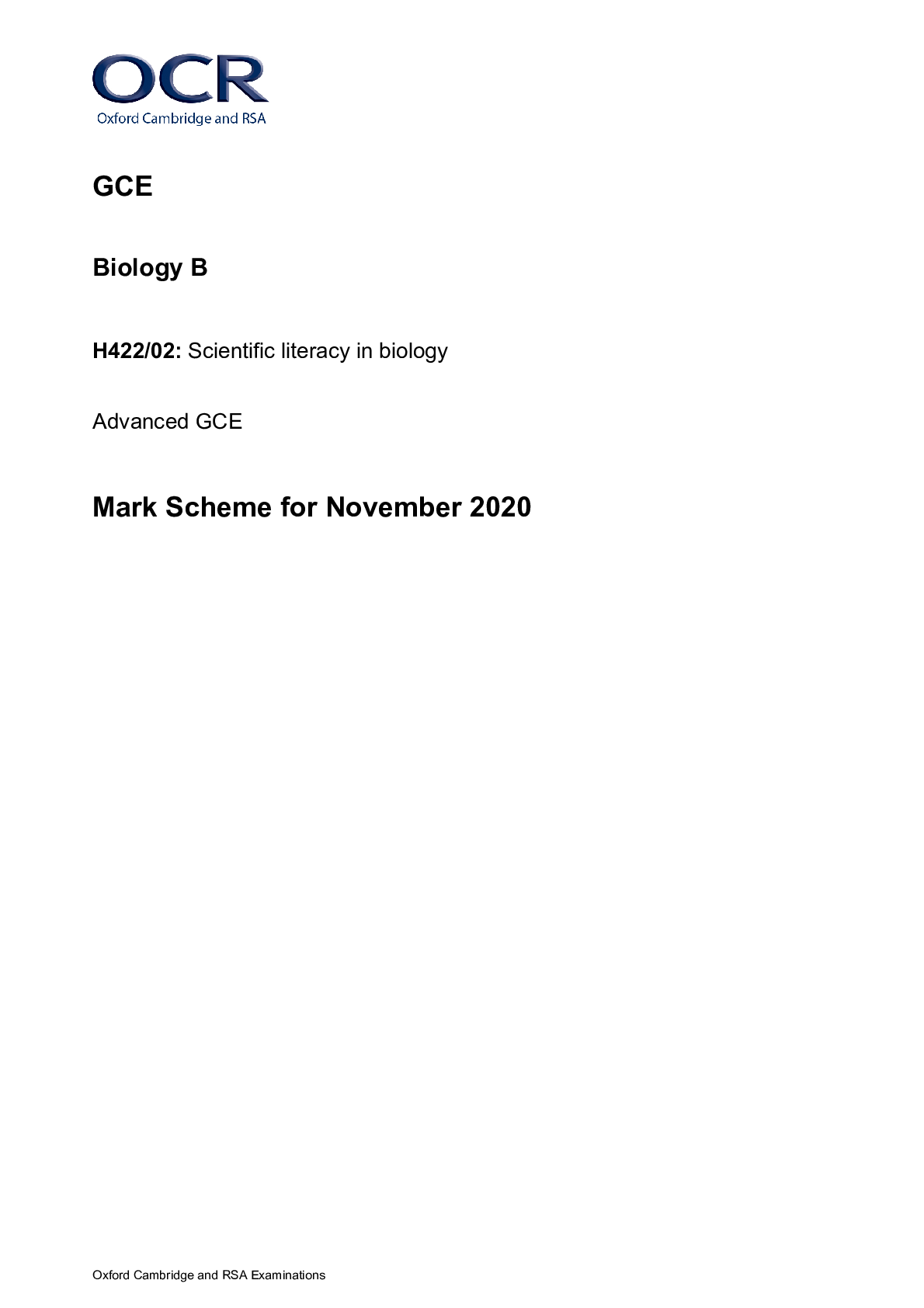
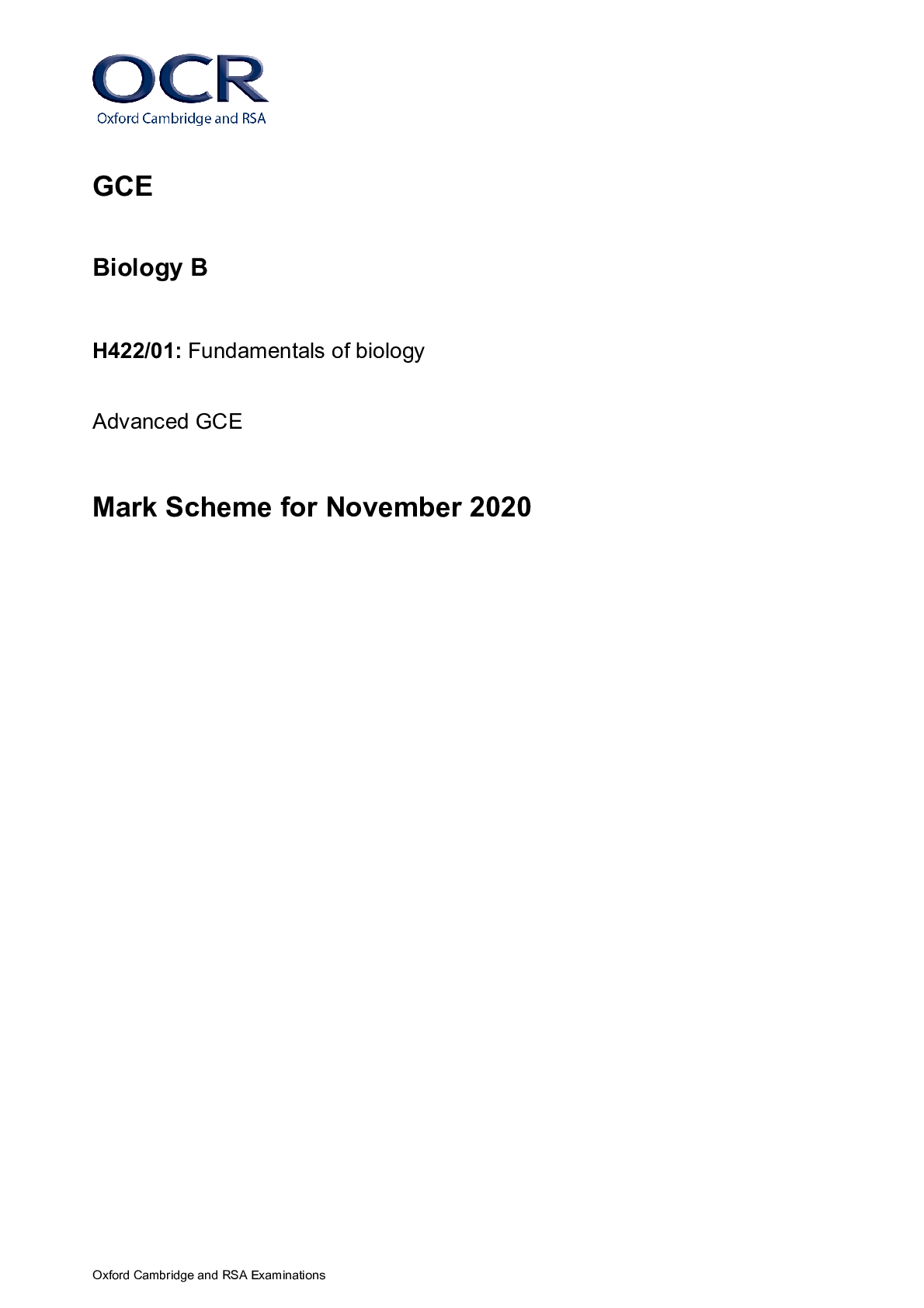

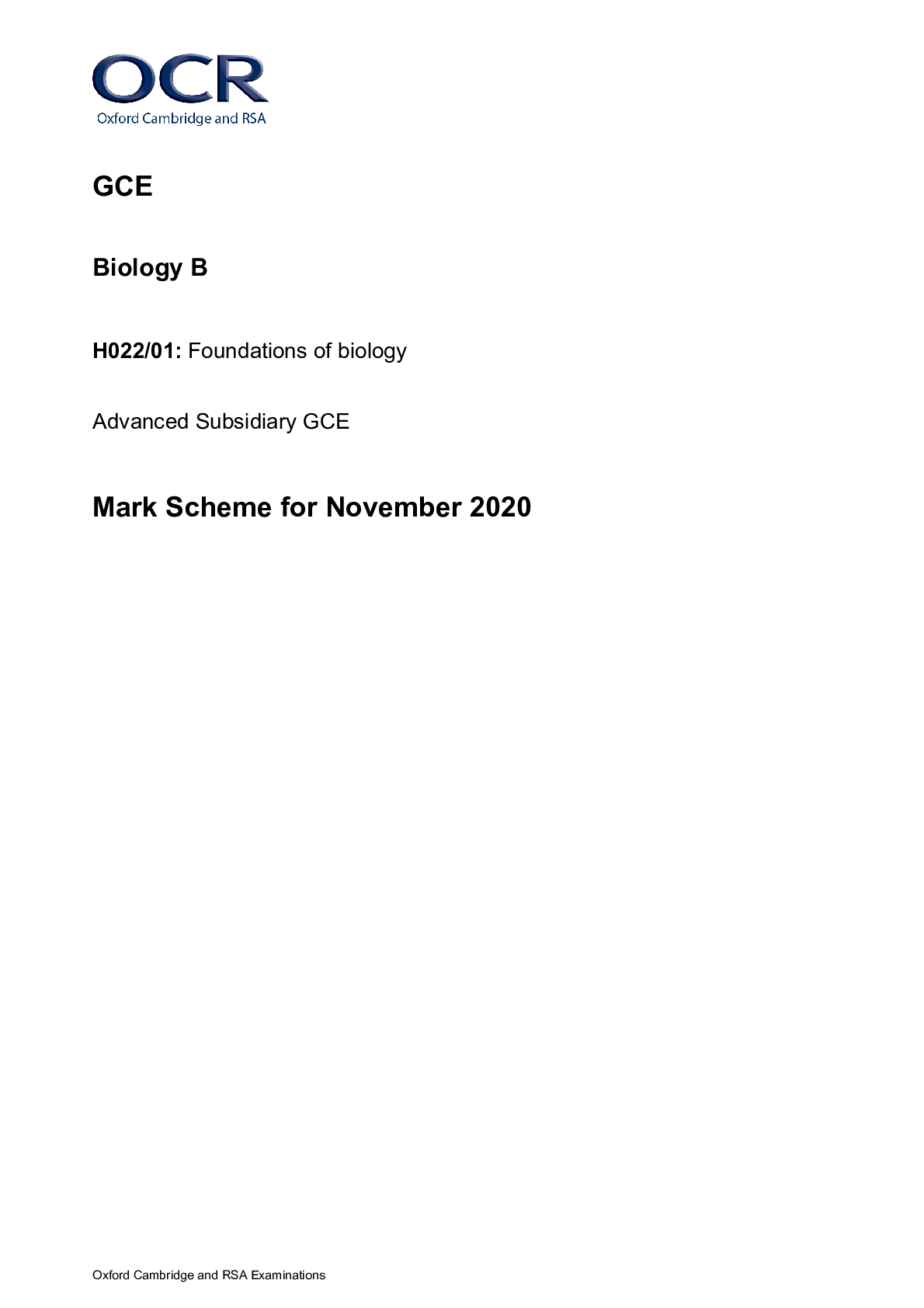
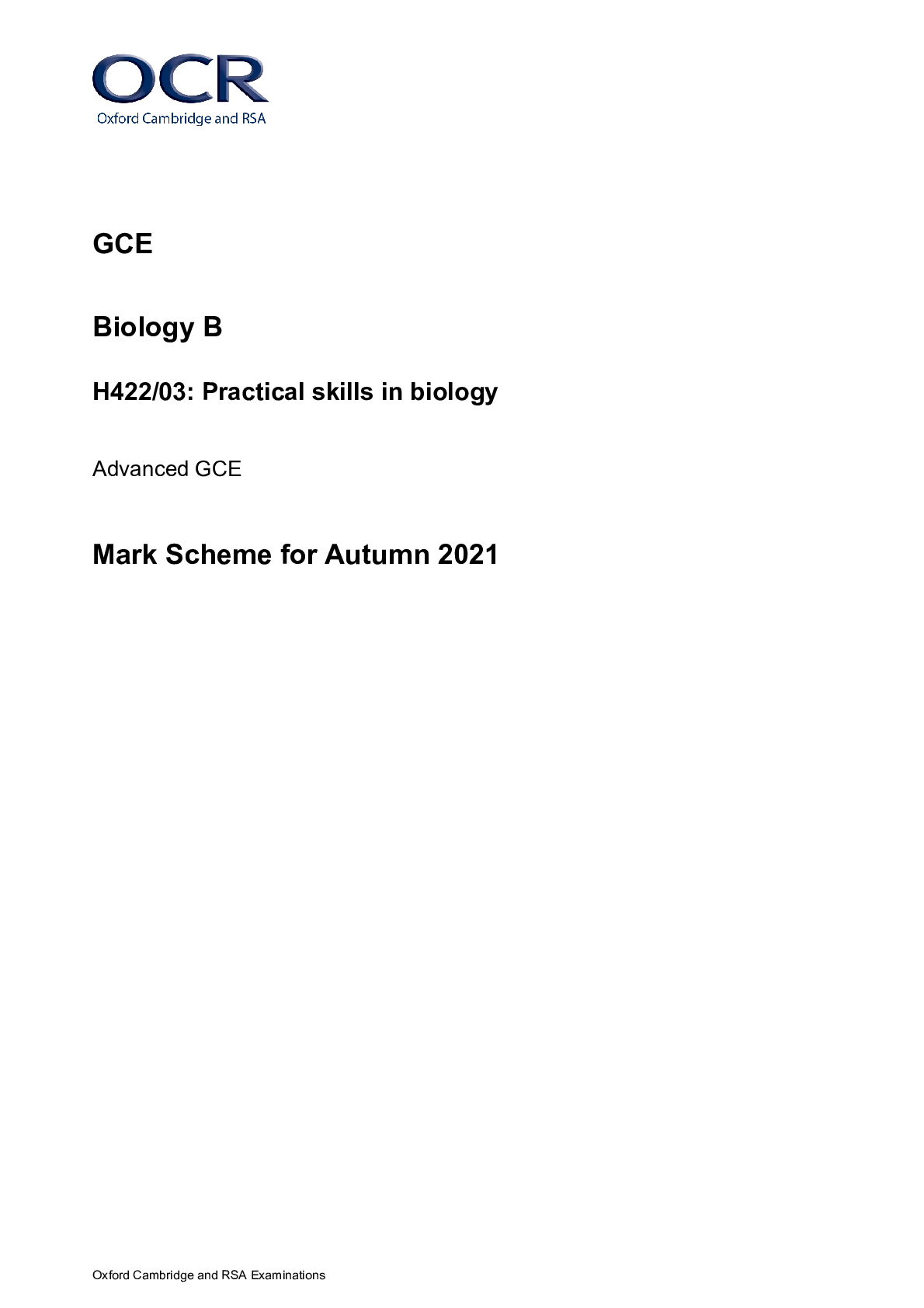
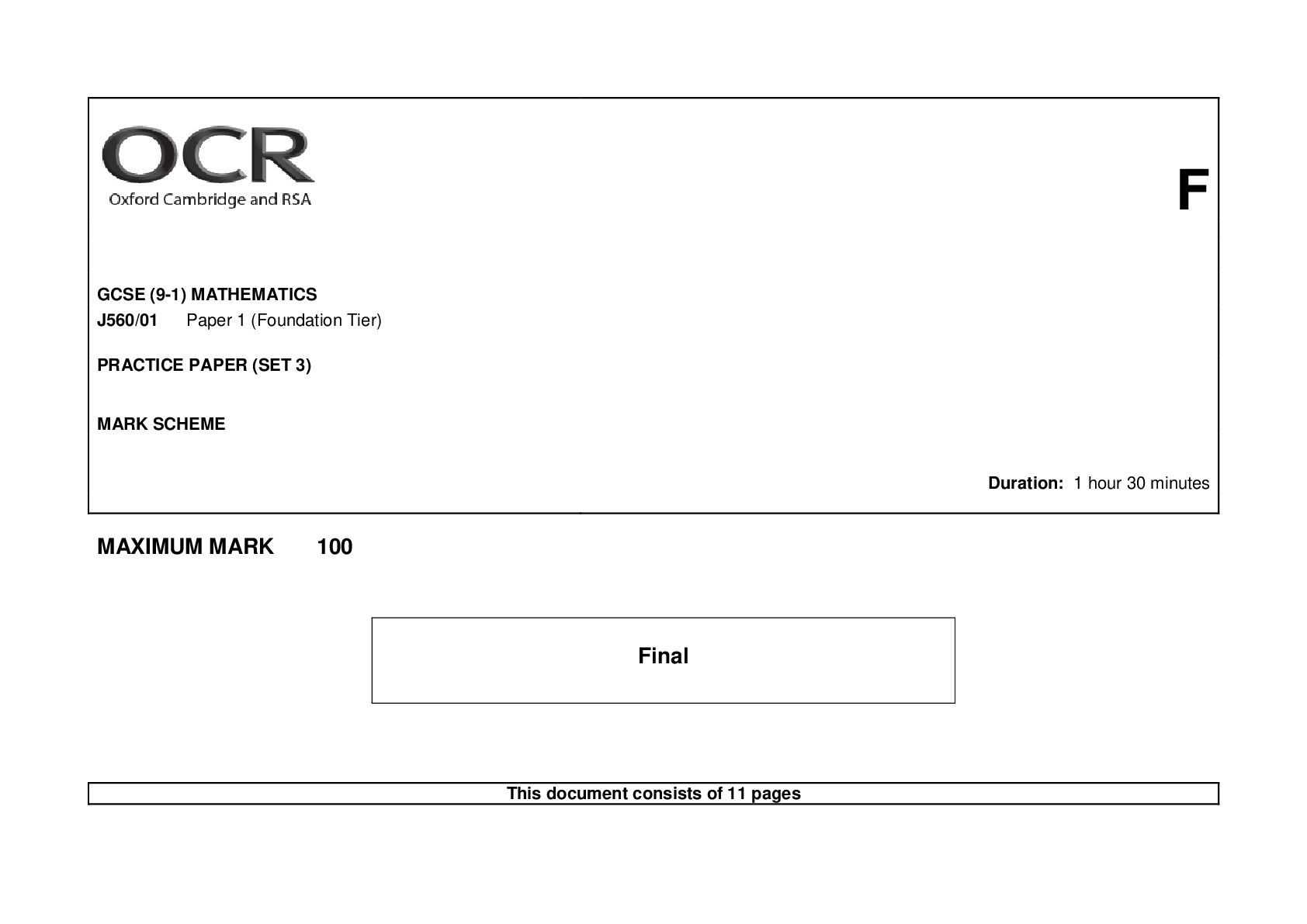
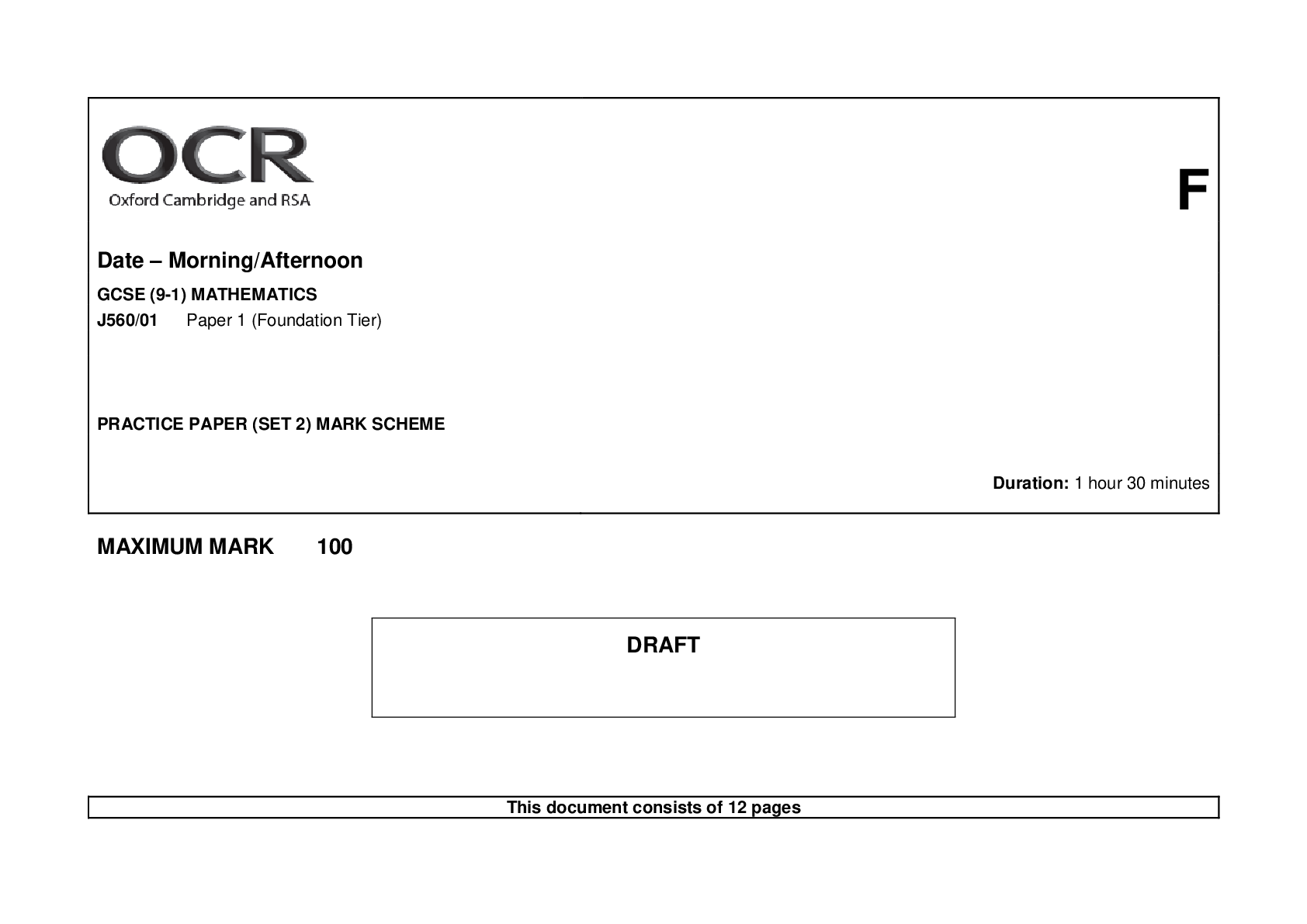
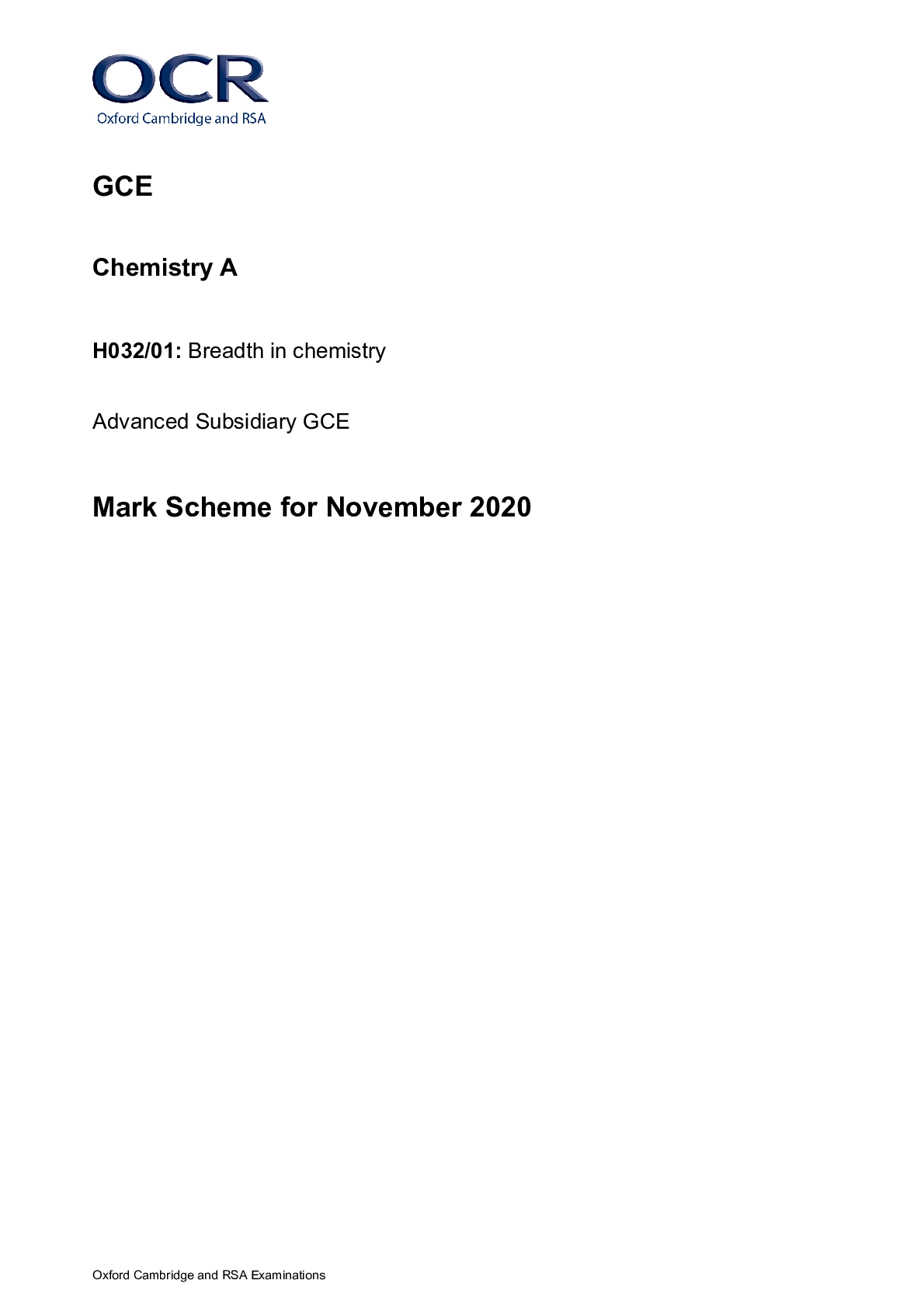

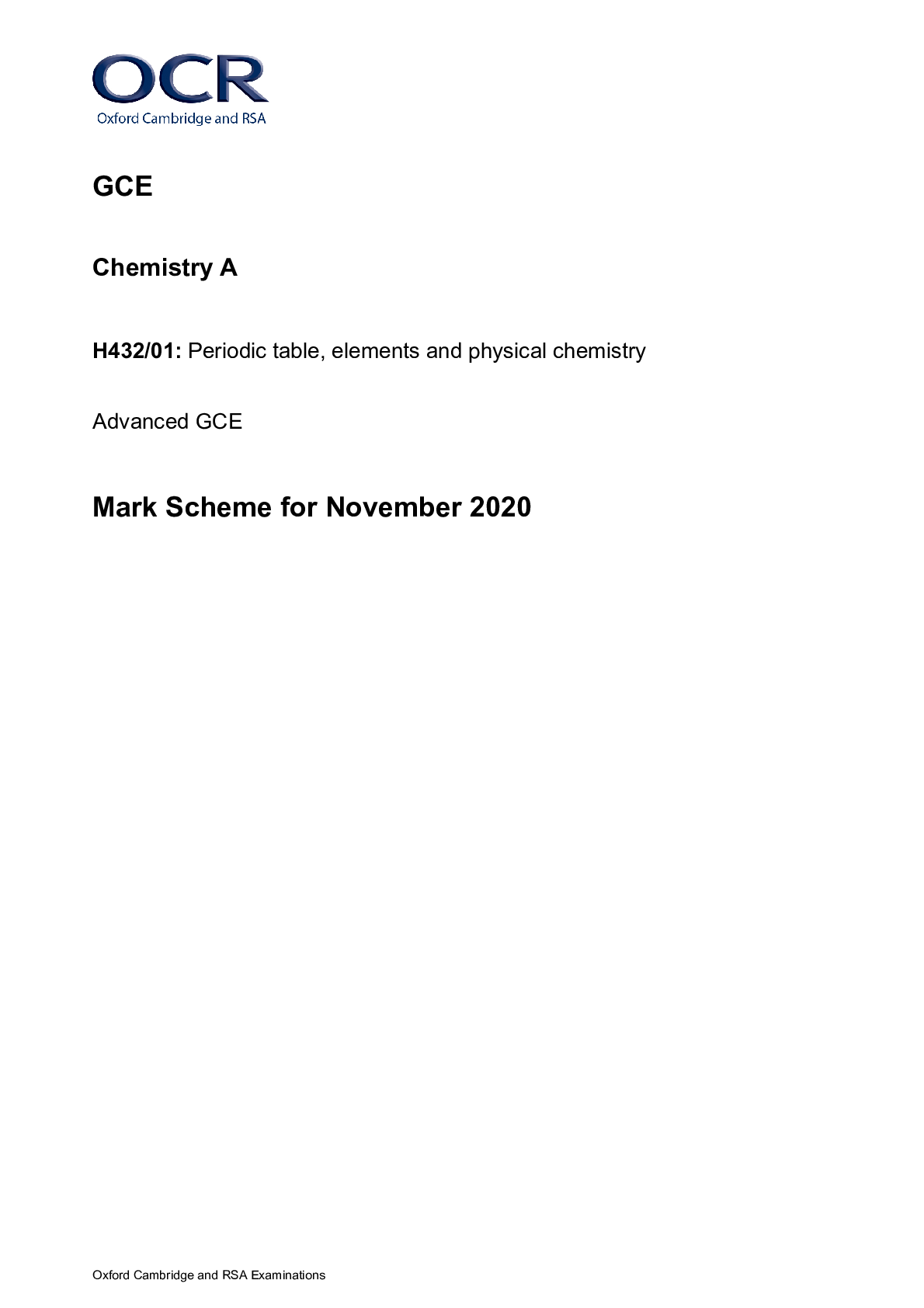
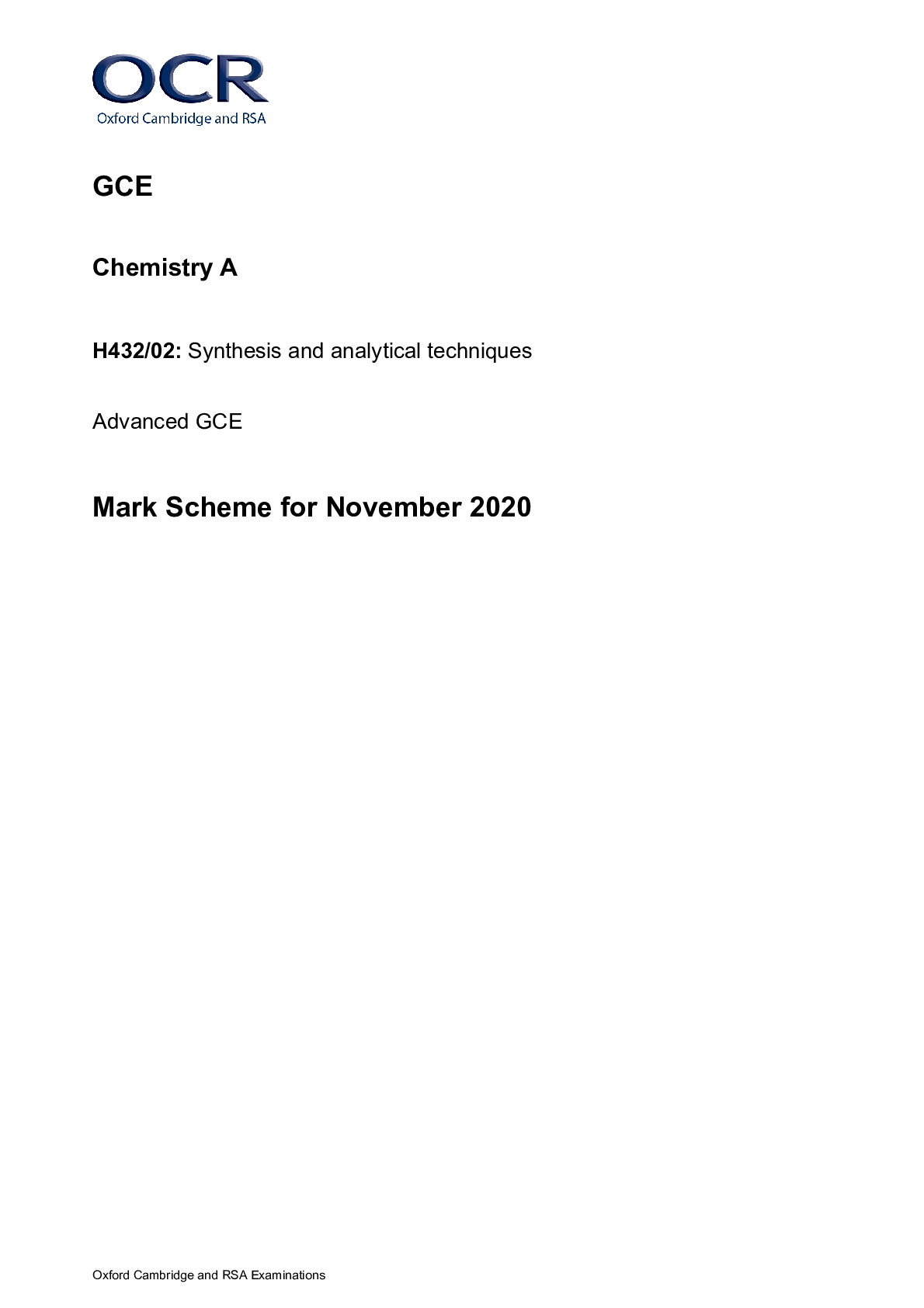

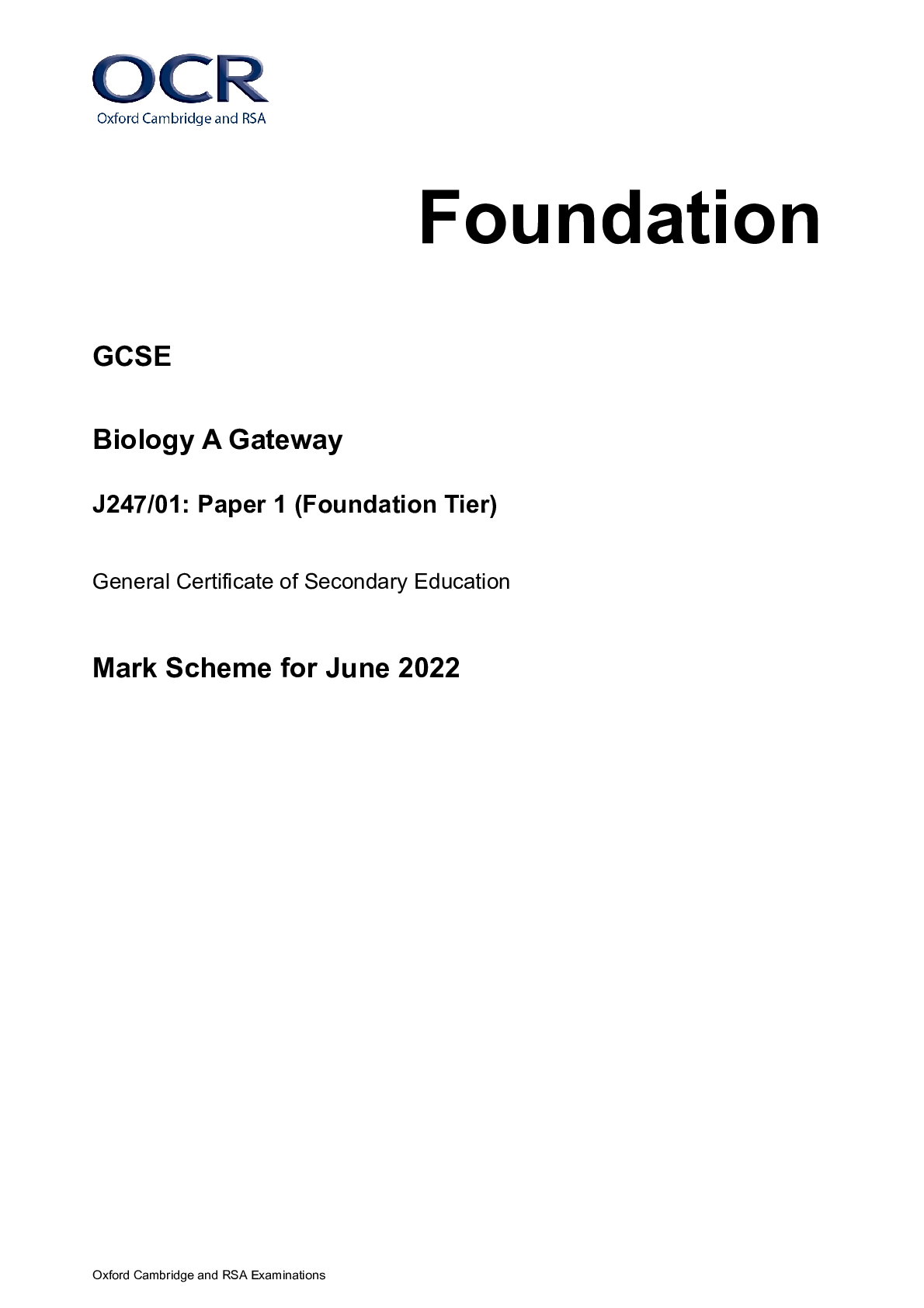
H630-02 Pure Mathematics and Statistics Advanced Subsidiary GCE Mark Scheme for Autumn 2021.png)


.png)

